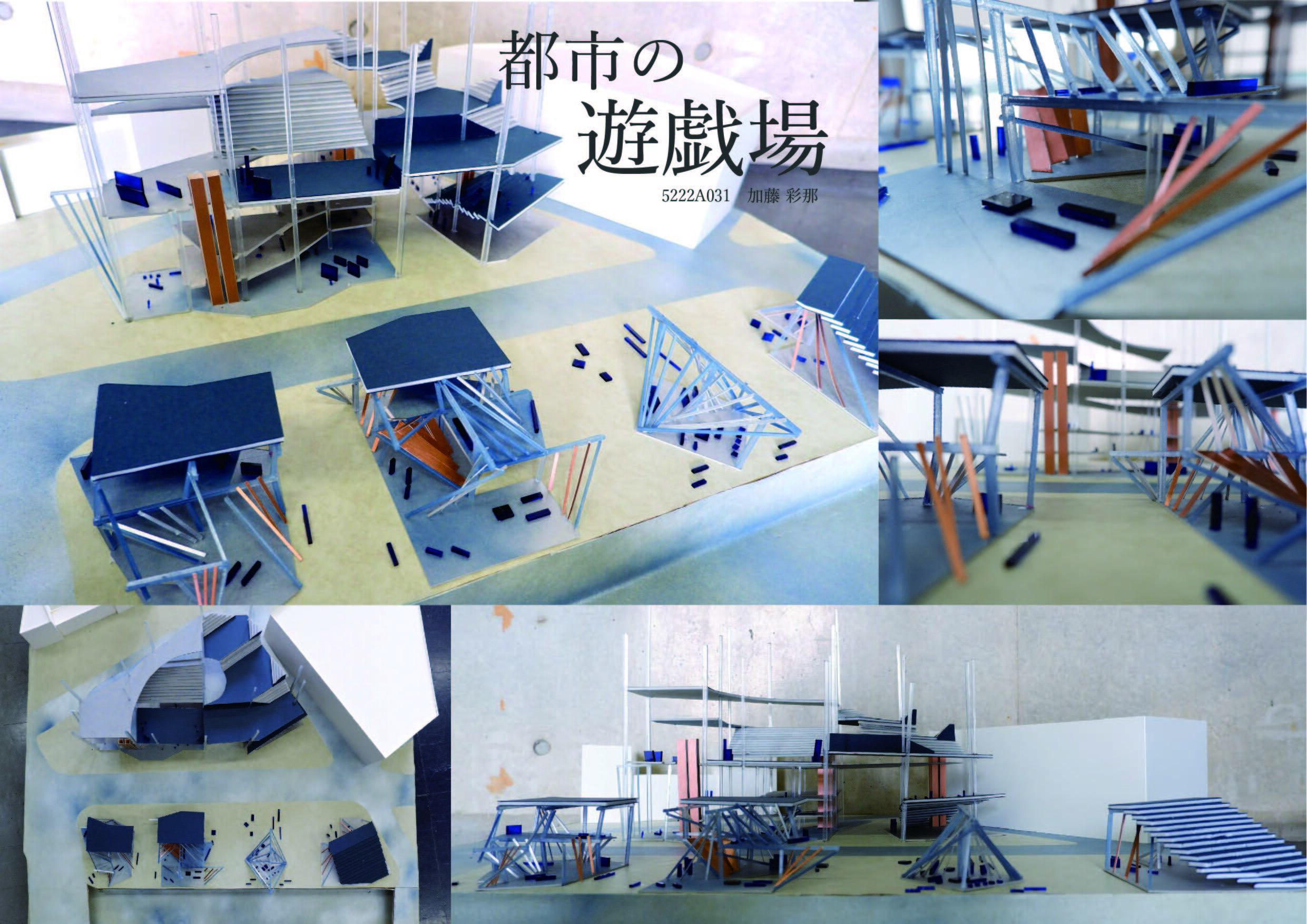
|
In 2040, the Metropolitan Expressway over the Nihombashi River will be underground, and the Nihombashi River will be connected to the sky.
In conjunction with this, redevelopment around the Nihombashi River will be promoted, and the city blocks will be integrated and transformed into a huge mass.
On the site between the Bank of Japan and the Nihonbashi River, which has been left behind by the redevelopment, could we conceive of a city where the urban void is created and people can live the way they want to live?
I consider creative and expressive acts as "play" in the city, and plan to create an art center that maximizes these "play”.
The project will construct a place for "play" by arranging a stage overlooking the river that can be used in different ways by performers, audiences, and for different purposes. As it proceeds, the city blocks will merge and become a huge mass.
2040年、日本橋川上空の首都高速が地下化され、日本橋川が空とつながる。それに伴い、日本橋川周辺では再開発が進められ、街区が統合し、巨大なマス化していく。 再開発から取り残された、日本銀行と日本橋川に挟まれた敷地で、都市のヴォイドを生み、人々が生きたいように生きることのできる都市を構想できないだろうか。 創作、表現行為を都市の中での「遊戯」と捉え、「遊戯」を最大化する芸術拠点を計画する。川をのぞみ、演者、観客、用途に合わせて異なる利用のできる舞台を配置し、「遊戯」の場を構築していく。 |
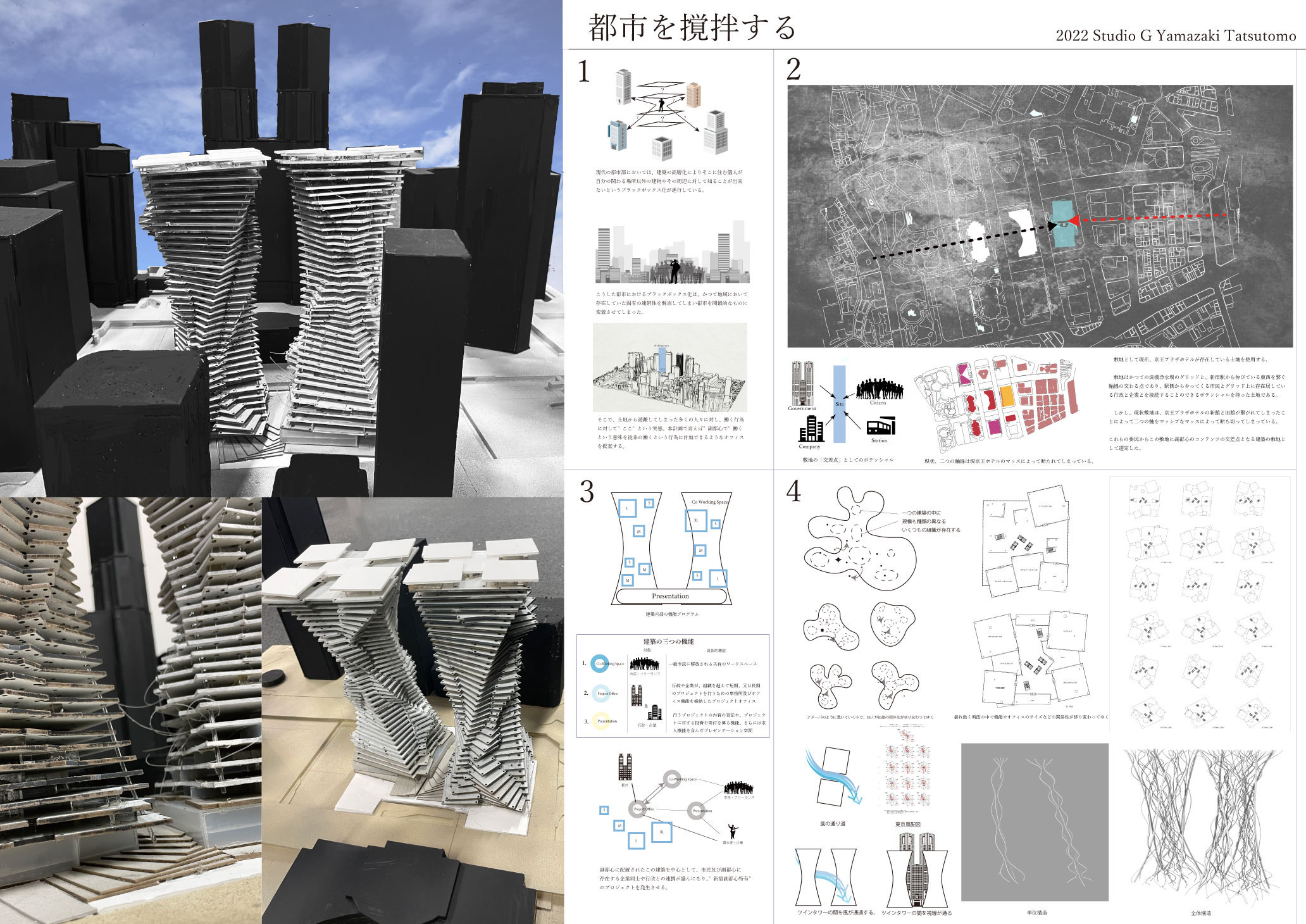
|
With the emergence of office buildings, the symbol of the modern city, we have lost the unique relationships that once existed around the land, which are not directly related to profit or organization, and which were created by sharing work and life.
This building, with its unique structure and location, has the function of "stirring up" the conventional rigidity of the city, triggering new activities and connections among people that are unique to the Shinjuku subcenter.
The architecture is divided into three main spaces: a presentation space, a co-working space, and a project office, and these spaces oscillate like an amoeba to form a single architectural structure. The organization and the composition of individuals will be agitated by the space that changes its composition as one goes up the floors, and it will be possible to create something unique in the sub-center of the city by using time and space as a factor.
現代の都市はその象徴であるオフィスビル群の出現によって、かつて存在していた仕事や生活を共有することによって生まれていた利益や組織に直接的には関係のない土地を中心とした固有の関係性を失ってしまいました。 この建築は、その特異な構造と立地によって新宿副都心特有の人々の繋がりやそこから生まれる新しい活動を誘発させる従来の凝り固まった都市を“撹拌する”機能を備えています。 建築は大きく分けてプレゼンテーション空間、コワーキングスペース、プロジェクトオフィスという三つの空間を内包しており、それらの空間がアメーバのように揺れ動いていくことによって一つの建築を構成します。階を上がるごとにその構成を変える空間によって組織や個人の構成が撹拌され、副都心においての時間、空間を因とした固有のものを生み出せるのではないだろうか。 |
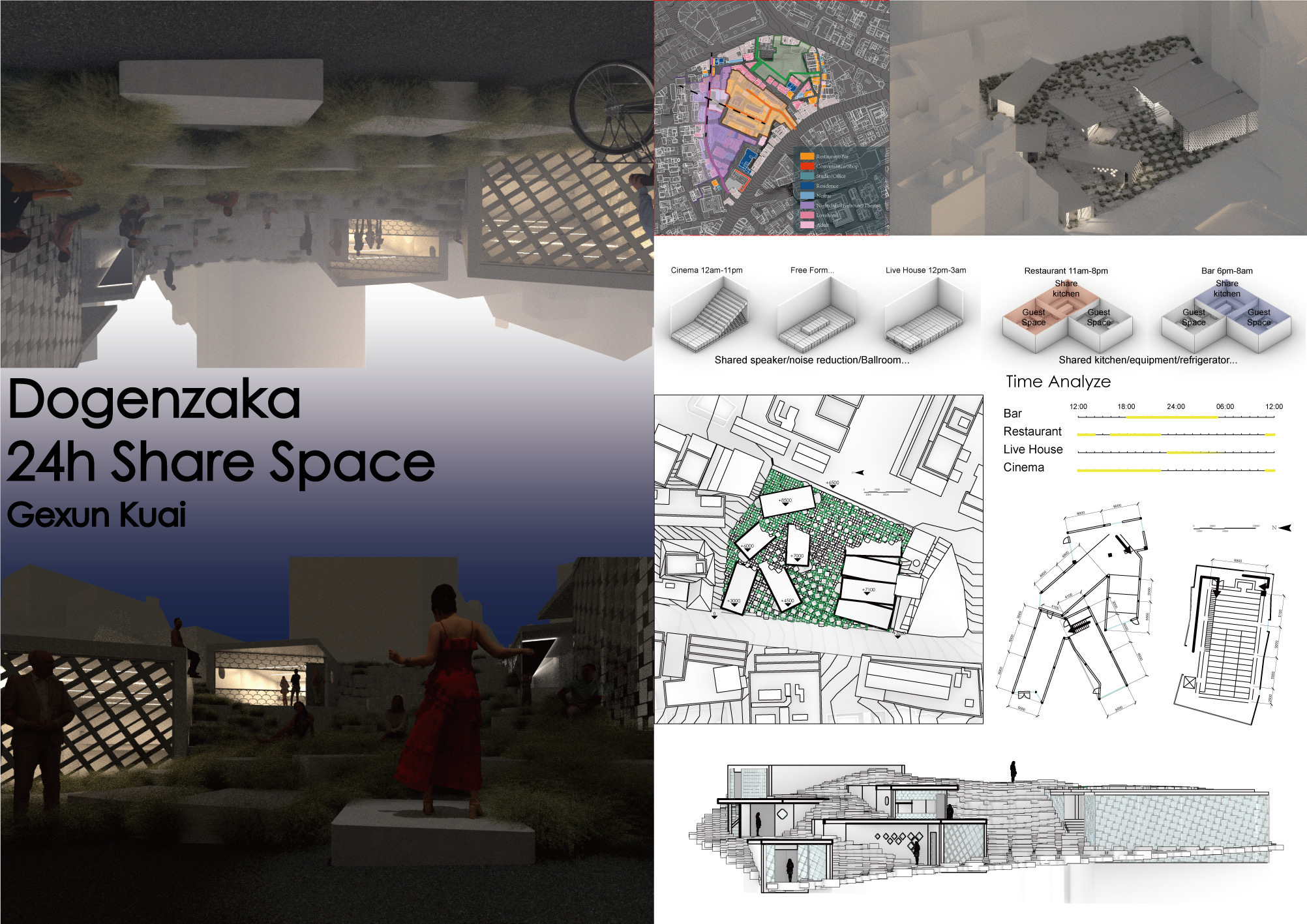
|
Dogenzaka is an island in the center of Tokyo for its special location and topography. Its shell and interior, east and west, day and night, are so isolated and distinct worlds.
This project chose a cliff at a key node as its site, hoping to reconnect these broken pieces of Dogenzaka by creating a new shared space for everyone. In space, this project will be the connection and fusion of two zone, an entrance to entre inner Dogenzaka. In time, it is except to extend Dogenzaka’s existing length and chrematistic verity in citizens’ daily life.
In mental, it is shaped to be a representation of the block; an open space to against the over chaos dense layout; and a free space could be defined by users’ own will.
道玄坂は、その特別な位置と地形により、都市中心部にある孤島になりました。 その殻と内部、東と西、昼と夜は、それそれ孤立した、異なった世界です。このプロジェクトは、新しい共有スペースを作成することによって、これらの道玄坂の破片を再接続することを期待して、敷地としてキーノードの崖を選択しました。空間的には、このプロジェクトは、2つのエリアの接続と融合、および道玄坂の内部への入り口になります。 時間的には,市民の日常生活中で道玄坂の存在と性格を引き延ばしていきます。 心理的には、過度乱雑と密集した道玄坂のレイアウトに対抗するための開放空間で、ユーザーが機能を定義するフリースペースです。 |
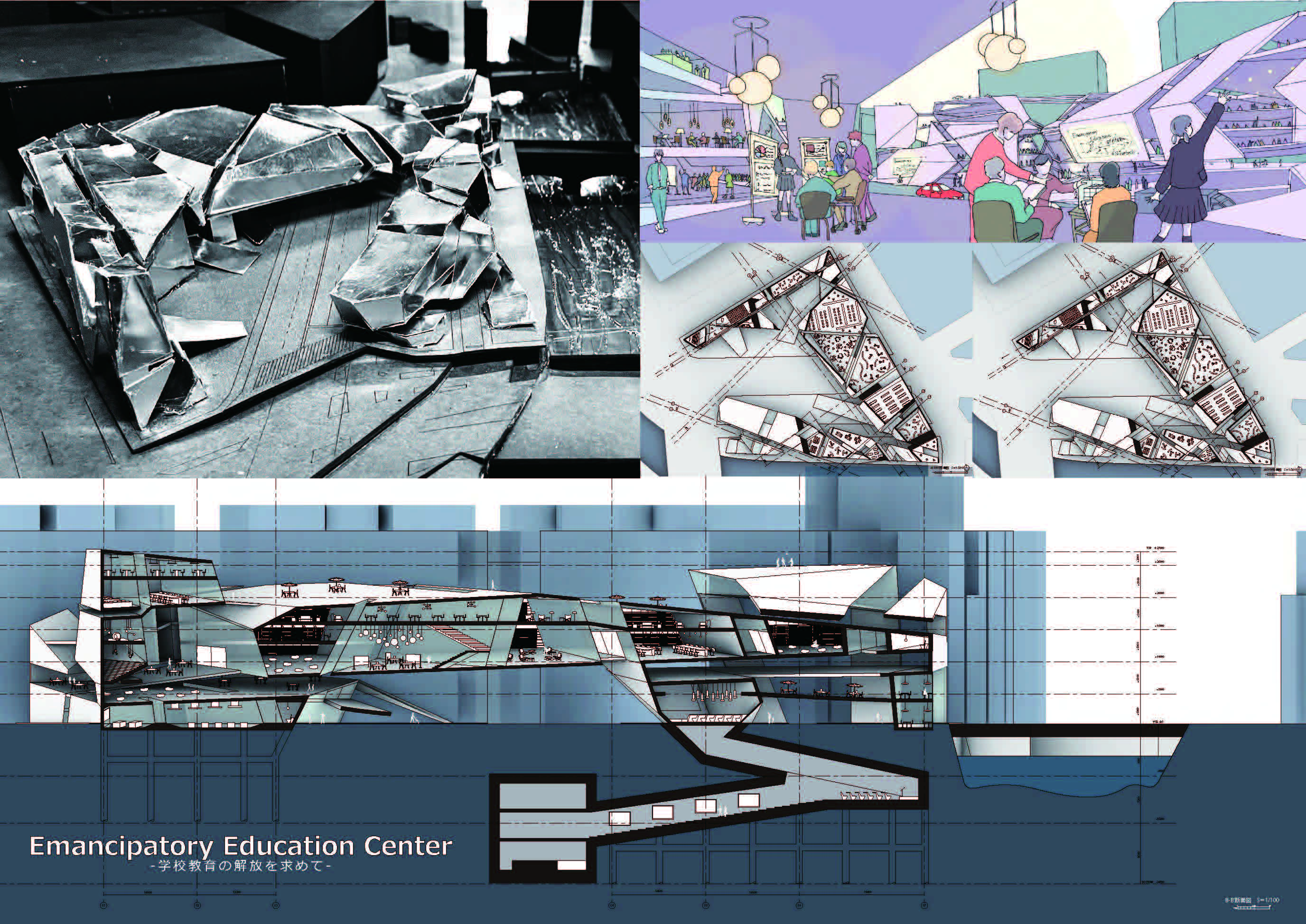
|
After repeated educational reforms, it was found that reforming educational policies alone would not bring about changes in learning.
High school students questioned the old educational policy, which was being swayed by teachers and the Ministry of Education, Culture, Sports, Science, and Technology.
We proposed a plan to materialize the high school education of the new generation as architecture.
Members of the society and some teachers who agreed with this project supported the students, and the companies that agreed provided the grounds of Nihonbashi under certain conditions.
This space, where people of different ages, occupations, and nationalities come together through learning, will add new value to Nihonbashi, which is centered on "capital," and will be a place to cultivate human abilities that cannot be measured by numbers.
Rather than a closed space that restricts activities, the architecture that allows the city to invade and permeate the building aims to be a place where people can learn without being isolated from society.
度重なる教育改革の末、教育方針の改革だけでは学びの変革は起こらないと分かった。 高校生たちは、教師や文部科学省に振り回される一方であった旧来の教育方針に疑問を持ち、 新世代の高校教育を建築として具体化する企画を提案した。 この企画に賛同した社会人や一部の教員は学生を支援し、また賛同した企業は条件付きで日本橋の敷地を提供した。 異なる年代・職種・国籍が学習を介して集うこの空間は、「資本」を軸とする日本橋に新たな価値を付与し、数字では測りきれない人間の能力を培う場となる。活動を制限するような閉鎖的な空間ではなく、建物内に街が侵入・浸透してくるような建築は、人々が社会と隔絶されることなく学べる場を目指す。 |
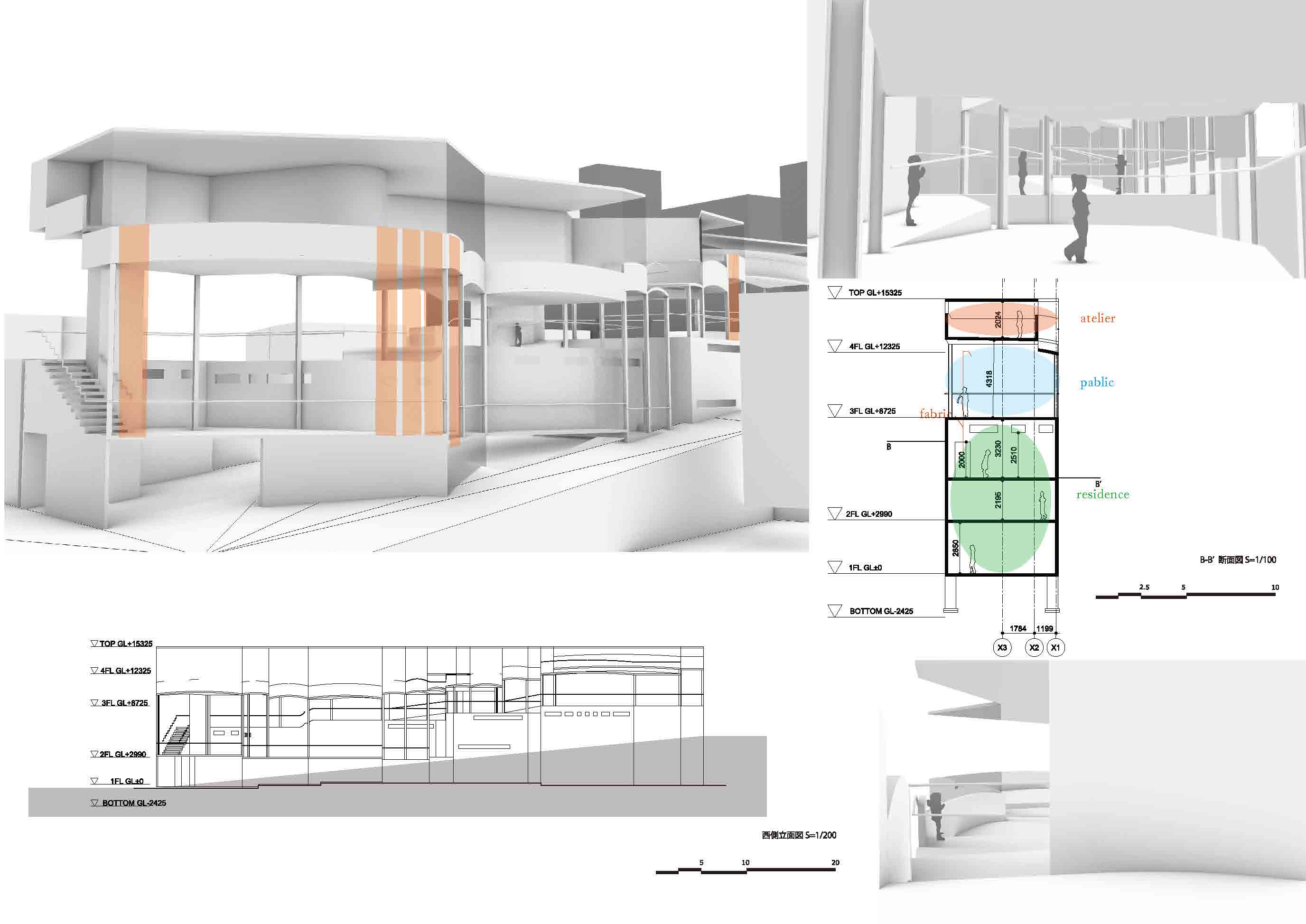
|
TToday's artists appeal to society with their own ideas in a variety of different mediums - oil painting, moving images and digital. At the same time, the development of information technology has led to the rise of digital worlds such as AR and VR, and their activities are being sucked into the information landscape.
The digitalisation of matter reveals unwritten details of previously unstated phenomena, but are our bodies able to adapt to such a shadow-cloudless world of information?
I propose a series of complicit creations by artists, architecture and pedestrians in urban spaces, in which the artist presents a cloth on which he has written his ideas as an architectural facade, and pedestrians in the public void either overwrite the ideas on the cloth, or cut them out and buy them back.
The project proposes a series of artist, architectural and pedestrian complicit creations in urban spaces.
今日の芸術家は、油画、動画、デジタル、それぞれが異なる様々な媒体で自らの思想を社会に対して訴えかける。一方で、情報技術の発達により、ARやVRのようなデジタル世界が台頭し、彼らの活躍の場も情報の中に吸い込まれようとしている。 物質のデジタル化は、それまで明文化されていなかった現象の不文律的なディテールを明らかにするが、私たちの身体はそうした影曇りのない情報の世界に適応できているのだろうか。 私は、芸術における身体性の再興をめざし、アーティストが思想を著した布を建築のファサードとして都市に示し、パブリックなヴォイドにおいて歩行者がその布に思想を上書きしたり、あるいは切り取って買い取る、という一連の、アーティスト、建築、歩行者の共犯的創造を都市空間で行うことを提案する。 |
Copyright (C) 2014 Watanabe Taishi Laboratory, Department of Architecture, Waseda University. All Rights Reserved.